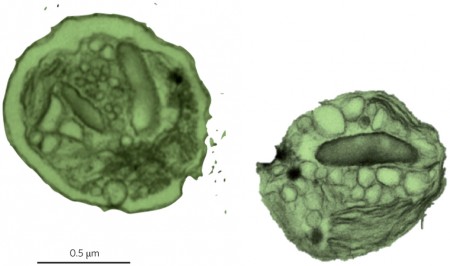July 6, 2015 – In some respects this is a good news story. A study appearing in the ISME Journal this month exposed 400 generations of phytoplankton to rising levels of CO2 in ocean water. At the highest levels the scientists anticipated what ocean conditions would be like by 2100. What they found is that phytoplankton populations exhibit genetic plasticity, adapting better than one would expect to an altered ocean environment.
The increasing concentration of CO2, altering the chemistry of the oceans, drove evolution in marine biota faster. The species chosen was ostreococcus (seen below), a picoplanktonic green algae, and researchers noted 16 physiologically distinct lineages evolving over 400 generations. These were categorized by cell to nuclei ratios and by overall cell size. Successful adaptation appeared better when CO2 levels fluctuated rather than when they remained stable.
The reported study is not the first that indicates algae will thrive in a changing ocean environment where more CO2 is present. In fact the adaptation of marine algae to CO2 level changes shouldn’t be too much of a surprise. Life that uses CO2 as a fuel is going to find a way.
But what this study didn’t look at is impacts of CO2 on zooplankton, far more vulnerable to increases that change the pH balance in the ocean. A more acidic ocean threatens animals that form exoskeletons and shells. That includes corals, shellfish, crustaceans and arthropods, the base of the ocean food chain.









General ambiguity seems to characterize most of the literature about phytoplankton population levels. What seems to be known for sure, and be confirmed by nearly countless and widely distributed Secchi disk results, is that in the last hundred years there has been a dramatic and alarming general decline . See: http://www.scientificamerican.com/article/phytoplankton-population/
So far there are only conflicting and unpersuasive suppositions as to just what
accounts for the decline. There is however an obvious inverse correlation
between human and phytoplankton population levels. More people–less
phytoplankton! Because we haven’t really identified any fully plausible mechanism
that is causing the decline, we should be highly skeptical of “scientific” projections of future phytoplankton levels. Instead of pretending it has rational answers to “global climate change” humanity would be well advised to direct its global climate change/CO2 buildup concerns and efforts toward the most basic phytoplankton questions.
Those who are concerned about atmospheric carbon ratios need to nurture their
assessments with phytoplankton, which is the largest natural carbon sink. The
gigatons of phytoplankton constantly employ solar energy to extract carbon from
the seawater, which through the complexities of the oceanic food chain eventually winds up in permanent abysmal sequestration. See: http://www.earthtimes.org/scitech/role-marine-plankton-sequestration-carbon/1062/
The study itself doesn’t address general phytoplankton decline. It specifically focuses on adaptability to changing levels of CO2 in marine environments. There is an overall decline in plant and animal biodiversity on the planet including population numbers with the exception of humans and our own attendant microbial populations. Water quality, changing ocean temperatures, sea ice melt in the Northern Hemisphere….you name it, we’ve been tinkering with the biosphere with unintended consequence. There is no doubt that we need to focus on the bottom of the food chain in addressing and mitigating global climate change. These creatures are the canary in the coal mine.